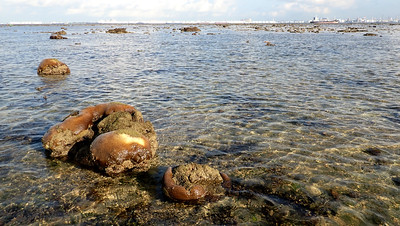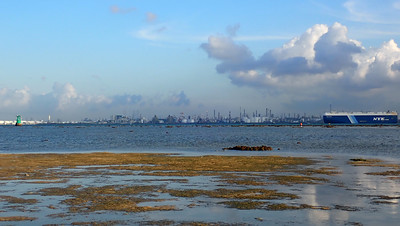Today, I didn't see any large corals that were full on bleaching, in fact many seemed to be recovering. About 5% were showing stress (paler than usual or with bleaching portions) or with recently dead patches. I didn't come across many leathery soft corals, most were alright. The situation wasn't as bad as what I saw during mass coral bleaching in 2016.
Seagrasses are sprinkling almost all the shore that I surveyed. I saw a few dugong feeding trails! And the Giant clam that we usually see here is doing well.
There are not a lot of hard corals on this shore. The large colonies that dotted the shore here and there were mostly nice and brown. Only a few had pale patches or recently dead patches. I didn't come across many leathery soft corals, most were alright.
This is what I saw here during mass coral bleaching in 2016.

The large Fluted giant clam near the arrival point that we have seen on our past surveys seems alright! We saw it first in Jun 2014. Giant clams can also suffer from bleaching, so it was a relief to see that this big mama clam is doing alright.
Near the sand bar, I saw lots of Oval moon snails, a few Common sea stars, one Cake sand dollar, a Strawberry cockle and a Moon crab.
There were denser patches of Spoon seagrass in the sandy centre of the reef flat. These were heavily covered in epiphytes. Spoon seagrasses were also the most common elsewhere, in some parts I saw those with large leaves.
Elsewhere to the reef edge, there were sprinkles of various kinds of seagrasses almost everywhere I surveyed. Much was also covered in epihytes.
I saw a variety of seagrasses. Also a few clumps of Tape seagrass that were cropped. The seagrass situation seems rather similar to what I saw on our last survey in May 2019.
Today, I saw a few dugong feeding trails in the thin meadows of Spoon seagrass near the arrival point. We didn't see any on our last survey in May 2019. We saw many trails in Dec 2018. Also in Aug 2016. The first time we noted them was in May 2012.
Today, there was this large broken abandoned fish trap on the sand bar near our arrival point. We often see fish traps on this shore. Fortunately, we didn't see any working traps in the areas where we surveyed.
Vincent also came across a small piece of fresh fishing net that had entangled and uprooted a sponge.
In the distance, there were two men who seemed to be collecting something from the shore, and putting these into a bright green plastic dinghy. There was a large dark green plastic bag nearby too. Eventually, as I got closer, they moved to the white sampan that they must have arrived in. I saw them transfer the large dark green bag into the sampan.
Terumbu Pempang Laut is one of our largest submerged reefs and located near industrial islands such as Jurong Island and Pulau Bukom.

What is the fate of Terumbu Pempang Laut?
Terumbu Pempang Laut is one of the existing natural shores that may be impacted by the landuse plan by the Ministry of National Development released in Jan 2013 in response to the Populations White Paper with a 6.9 million population target. The dotted margined blue areas are "Possible Future Reclamation".


Posts by others on this survey
Vincent Choo
Marcus Ng
Joleen Chan
And Russel Low












